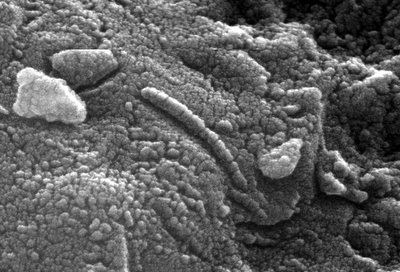
By Frank Warren
The UFO Chronicles
© 11-30-09
What Was Once Old—Nay, 'Very Old' is New Again
The meteorite discovered at Alan Hills, Antarctica on December 27, 1984, tagged ALH 84001, which was later determined to be from the planet Mars became the focus of a heated debate over ten years later; in 1996, (after sitting on a shelf for a decade) a press conference took place where a group of NASA scientists, supported by three universities and lead by Dr. David S. McKay announced to the world, that “evidence of primitive life once lived on the red planet.”The UFO Chronicles
© 11-30-09
To no one’s surprise, this caused ripples throughout the scientific community, and a rift quickly emerged. In lay terms what McKay & company put forward, was that certain hydrocarbons present in the rock could only be formed by “bacterial decomposition”; the opposition said the result could be caused by other means.
Carl Sagan was quick to denounce the theorem stating:
"The findings are evocative and very exciting; however, the chemical compounds reported in the paper 'are not evidence of life . . .'"As one might imagine, the announcement had many collateral effects: talk of “manned missions to Mars” became prevalent; although I haven’t checked, I think it’s safe to say that UFO sightings probably increased. It’s certain, that no matter one’s title in this trek we call life, the notion that we are not alone gave everyone pause to a certain degree.
In spite of the impact of the revelation, like all things—this too passed into history . . . that is, until just recently. It seems that Dr. McKay has got back on the proverbial horse and is espousing a new analysis technique, called “ion beam milling.”
According to McKay & Co, this new technique eliminates at least one of the proposed reasons of what his opponents claimed to cause the origins of the hydrocarbons (what he believes is bacterial decomposition).
The "Magnetites" (as they're called), which appear in the image looking like petrified microbial worms are very similar to what is found here on earth (part of the original argument). That said, this is still isn’t enough to satisfy his iconoclasts.
Michael Fuller, of Hawaii's Institute of Geophysics and Planetology stated, "The grain-sized distribution is pretty small, . . . once iron particles get smaller than about 20 nanometers, the magnetism breaks down . . . It doesn't look to me that they are very similar to magnetotactic bacteria . . . "
When the news of the possibility of (microbial) life broke the first time, I often pondered the idea that perhaps this was the PTB’s way of “breaking of the ice” . . . of softening the blow so to speak, that we’re in good and great company in the galactic scale of things.
In any event, I look at the rekindled debate as a good thing! Perhaps they’ll pull another rock off the shelf that may tell us a little more . . .?
.png)
No comments :
Post a Comment
Dear Reader/Contributor,
Your input is greatly appreciated, and coveted; however, blatant mis-use of this site's bandwidth will not be tolerated (e.g., SPAM, non-related links, etc).
Additionally, healthy debate is invited; however, ad hominem and or vitriolic attacks will not be published, nor will "anonymous" criticisms. Please keep your arguments/comments to the issues and subject matter of this article and present them with civility and proper decorum. -FW